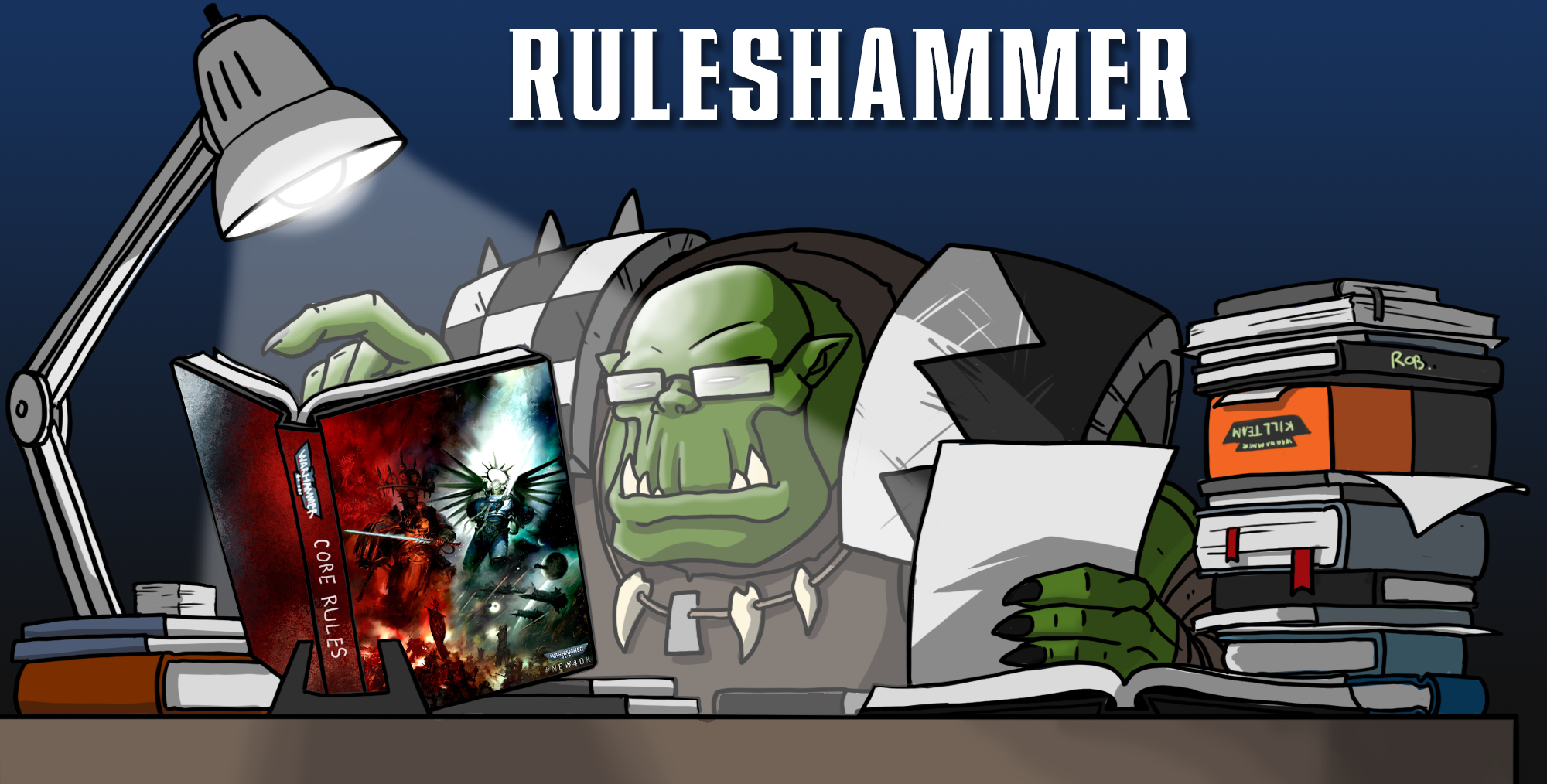This week on Ruleshammer, after some delay, Codex Necrons! You may recognise some of these questions from the last few months. We’ve collected the most common questions about the faction we’ve seen here, and added a few you might not have seen before. 
Current Q&A
Sareptek Heavy Constructs Moving around Terrain
As sold this comes without a base… mostly because it’s what we’d describe in technical terms as “fucking massive.” However, it does have a rule that gives them an “imaginary base”.
Designer’s Note: If this model does not have a base, before deploying this model, both players must agree the footprint of this models ‘base’ in the same way they would for an Area Terrain feature. We suggest that an imaginary straight line should be drawn from each point on this model which would touch the battlefield when it is placed on a flat surface. The area within these lines should be considered to be this model’s ‘base’.
If the model has been posed with one or more of its legs raised, agree with your opponent the point where that leg would touch the battlefield, and use this to advise the shape of the models ‘base’.
Which poses the question about how this model moves around terrain. To which the answer is, frustratingly, “awkwardly.” The note gives it a base and bases can’t intersect through terrain so neither can imaginary ones. This would prevent a Sareptek from standing with legs on either side of a short wall and does significantly limit their movement on the typical battlefield. It wouldn’t be the first model that is basically incompatible with a typical 2,000-point game at the moment; Fortifications are basically undeployable as well.
Damage Reduction vs Night Bringer
Q: How does damage reduction interact with the Night Bringer’s ability to prevent enemy models from ignoring wounds? This was an odd one but I felt it worth noting that these abilities are not the same. The Night Bringers ability is very specific in that units can not “ignore the wounds it loses”. Drain Life: Each time this model makes a melee attack that is allocated to an enemy model, that enemy model cannot use any rules to ignore the wounds it loses. Damage reduction abilities trigger before wounds are lost by modifying the damage of the attack. So the model has no lost wound to ignore losing as it never lost it in the first place. So Drain Life has no impact on damage reduction abilities.
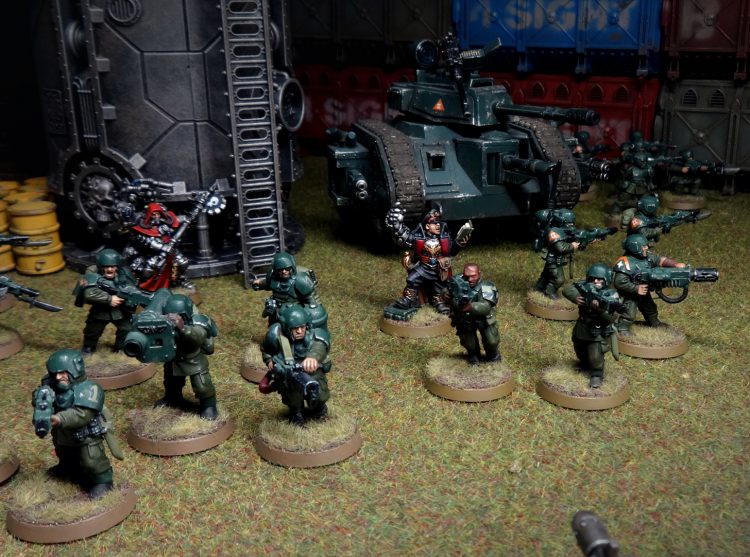
Technomancer Reanimation Rites whilst Deploying Teleporters
Q: Can a technomancer use rites of reanimation in the 3rd round command phase? If it is performing repair teleport homer from the previous round. To refresh everyone’s understanding of the teleport homer action (I’m going to refer to the slightly different secondary from GT2021 but the action timing is identical – the only change is to VP scoring) this action is completed at the end of your next command phase.
Deploy Teleport Homer (Action): One INFANTRY or BIKER unit from your army can start to perform this action at the end of your Movement phase if it is wholly within 12″ of your opponent’s deployment zone. The action is completed at the end of your next Command phase provided the unit attempting it is still wholly within 12″ of your opponent’s deployment zone.
o really it boils down to is using Rite of Animation one of the ways that an action can fail? These are listed in the action rules section, found on pg 75 of GT2021.
If a unit is destroyed, makes a Normal Move, Advances, Falls Back, attempts to manifest a psychic power, declares a charge, performs a Heroic Intervention or makes any attacks with ranged weapons after it has started to perform an action but before that action is completed, that action is failed. Otherwise, that action is successfully completed. A CHARACTER unit cannot use any aura abilities while it is performing an action (if the action is failed, their aura abilities immediately take effect again).
And fortunately for the Technomancer Rites of Reanimation is not an Aura ability so there’s not limitations on it using the ability whilst the action is still incomplete.
Rites of Reanimation: In your Command phase, you can select one friendly <DYNASTY> CORE unit within 6″ of this model. One destroyed model from that unit is Reanimated. If the selected unit is a NECRON WARRIORS unit, D3 destroyed models from that unit are Reanimated instead. Each unit can only be selected for this ability once per phase.
Lychguard and Overwatch
If a Necron Nobel is in range of a lychguard unit with guardian protocols and declaring a charge against an enemy unit – is the character immune to overwatch? – Czeak Yes.
Guardian Protocols (Aura): While a friendly <DYNASTY> INFANTRY NOBLE or DYNASTIC AGENT INFANTRY NOBLE unit is within 3″ of this unit, enemy units cannot target that unit with ranged weapons.
Similar to new Body Guard rules in the SM codex and for Blightshroud Terminators from Death Guard this ability is not ignored by Overwatch. Overwatch only ignores abilities;
Any rule that states the unit cannot be targeted unless it is the closest target (e.g. Look Out, Sir) does not apply when firing Overwatch.
…And the Guardian Protocols ability doesn’t have an “unless the character is the closest model” restriction.
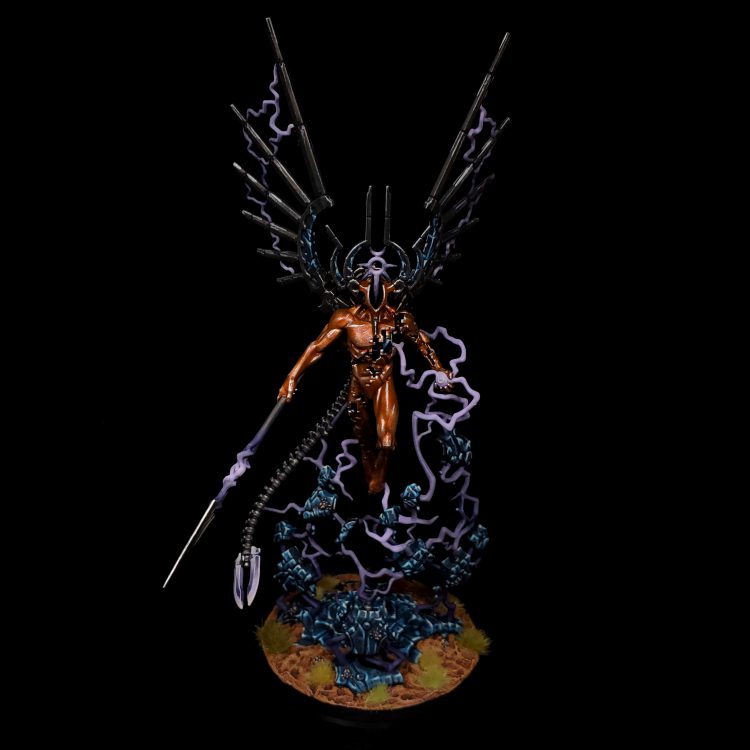
Void Dragon Voltaic Storm vs Double Wounds abilities like Flesh is Weak
I am about to play a round against an Iron Hands player. We both want to play more competitive so I will try a list similar to the Necron monster mash. I was wondering about the C´tan ability of the Voidragon though. His ability states that […] if that unit is a VEHICLE whose characteristics change as it loses wounds, then halves the number of wounds […]. How does this interact with a rule like “The Flesh is weak”? – Zuwi
The Voltaic Storm power ability says,
…until the start of your next turn, if that unit is a VEHICLE whose characteristics change as it loses wounds, then it halves the number of wounds it has remaining when determining what characteristics to use.
and then the Flesh Is Weak says,
Models with this tactic whose characteristics can change as they suffer damage are considered to have double the number of wounds remaining for the purposes of determining what those characteristics are.
So this might be a rather dull answer but I think the net result is that they end up with their actual wound count being used. If you double something and then halve it, you get what you started with. The order in which that happens doesn’t matter so the sequencing of rules makes no difference either.
How does the new Reanimation Protocols work?
The new Necron reanimation is quite a change from the old one, some parts of it are easy to mistake for being similar to an ignore wounds ability. As such I have put together a few examples to help illustrate how this ability works. 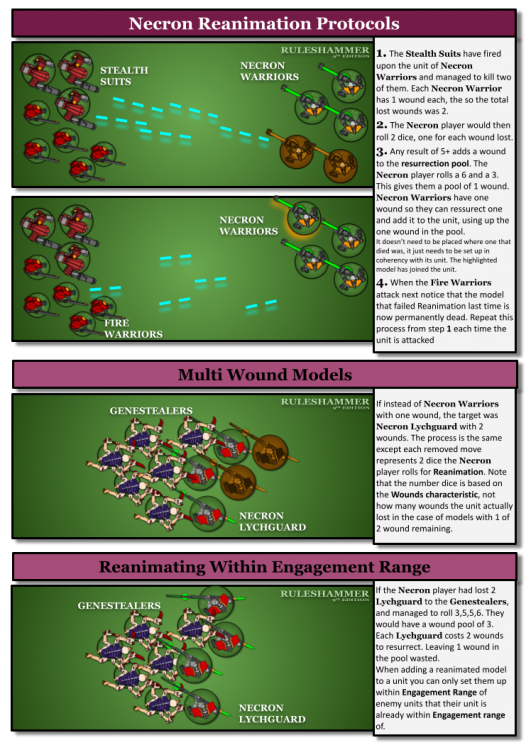 I hope those examples are helpful. Generally the new reanimation protocols are somewhere between the old version and a normal ignore wounds ability (often referred to as a Feel No Pain or FNP). For single wound models it’s a lot stronger than a normal FNP because it ignores extra damage, it’s just a single roll. For multi wound models it varies in its effectiveness compared to a FNP depending on the circumstances (generally better against massive overkill, but weaker as the wounds per model increase) but it’s less effective than the old Reanimation Protocols was for them as they now need to succeed multiple times to bring back a model.
I hope those examples are helpful. Generally the new reanimation protocols are somewhere between the old version and a normal ignore wounds ability (often referred to as a Feel No Pain or FNP). For single wound models it’s a lot stronger than a normal FNP because it ignores extra damage, it’s just a single roll. For multi wound models it varies in its effectiveness compared to a FNP depending on the circumstances (generally better against massive overkill, but weaker as the wounds per model increase) but it’s less effective than the old Reanimation Protocols was for them as they now need to succeed multiple times to bring back a model.
Where to place resurrected models
The main thing I was looking out for in the Necron FAQ was a clarification on bringing models back when using reanimation protocols. When reading the rule, there’s not a line stating specifically where they must be placed (such as in coherency) which means it could be interpreted quite extremely if you really wanted to abuse the rule. If I have 20 models in a warrior unit and 16 are killed, and I then roll 7 successful rolls, there’s nothing to stop me placing these 7 models in a completely different location such as on an objective on the other side of the board… – Tom Merrick There actually is an answer to this; it’s just not in the Necron Codex. It’s actually found in the Unit Coherency section.
Some rules allow you to add models to a unit during the battle, such models must always be set up in unit coherency with the unit they are being added to. Sometimes there will be insufficient room to set up all models from a unit, or it will not be possible to set up all the models so that they are in unit coherency. When this is the case, any models that cannot be set up are considered to have been destroyed.
So when bringing them back you need to set them up in coherency. 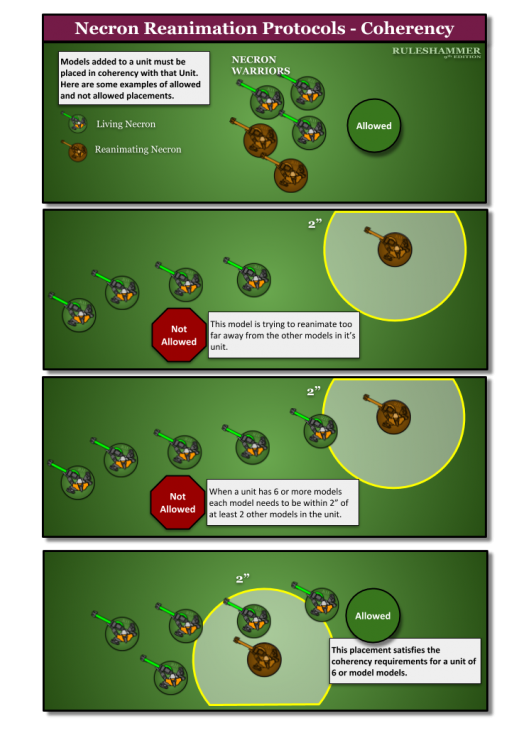
Relentless Expansion an Aircraft into Reserves
Hi, can necrons use ‘relentlessly expansionist’ (the pregame 6 inch move) to put an aircraft into strategic reserves? (E.g. you move your night scythe into reserve ready to bring it on T2 and deliver your lychguard bomb). I’m not sure if the minimum move of 20 inches would stop this, or in fact if you could even move a flyer off the board and into reserves, as the rule says that aircraft can move into reserves in their movement phase. Thanks! – True son of Dorn Okay so there’s a few things to unpack here. I think best not in the order you’ve asked though. For those not in the know here’s the Relentless Expansionist Necron trait.
At the start of the First Battle Round, before the first turn begins, units with this code can make a Normal Move of up to 6”.
Does an Aircraft Minimum move cause any issues?
No. This is because the AIRCRAFT minimum move requirements are during “its movement phase”.
The first is the model’s minimum Move characteristic – in its Movement phase, all parts of the model’s base must end the move at least that far from where they started. – [Core Rules PDF Pg13, GT2020 Pg66]
So AIRCRAFT with a minimum move can still make the up to 6” move without automatically putting themselves into Strategic Reserves because they can’t move their full minimum.
But can I choose to put the Aircraft in Strategic Reserves if I want to?
Actually also no, mostly for the reasons you found. They are only moved into strategic reserves in the movement phase. The wording does get a bit confusing though so my confidence on this is only 99% specifically the part starting “similarly”.
If you have a Battle-forged army, AIRCRAFT units from your army can, in your Movement phase, move off the edge of the battlefield (assuming it has sufficient Move for any part of its base (or hull) to touch the edge of the battlefield). If an AIRCRAFT unit does so, it is placed into Strategic Reserves. Similarly, if you have an AIRCRAFT unit with a minimum Move characteristic that cannot make its minimum move, or is forced to move off the battlefield because of its minimum move, then it is placed into Strategic Reserves. In either case, placing the AIRCRAFT (and any units currently embarked within them) into Strategic Reserves in this manner does not cost any CPs and the unit can be set back up on the battlefield in your next turn, as described in Setting Up Strategic Reserve Units. [GT2020 Pg 81]
It would be easy to read that section and come to the conclusion that if AIRCRAFT can’t move their minimum they are automatically put into Strategic Reserves. However the key word there is “similarly”, encompasses the other criteria of the previous clause; having your army be battleforged and that it’s during the AIRCRAFT’s movement phase.
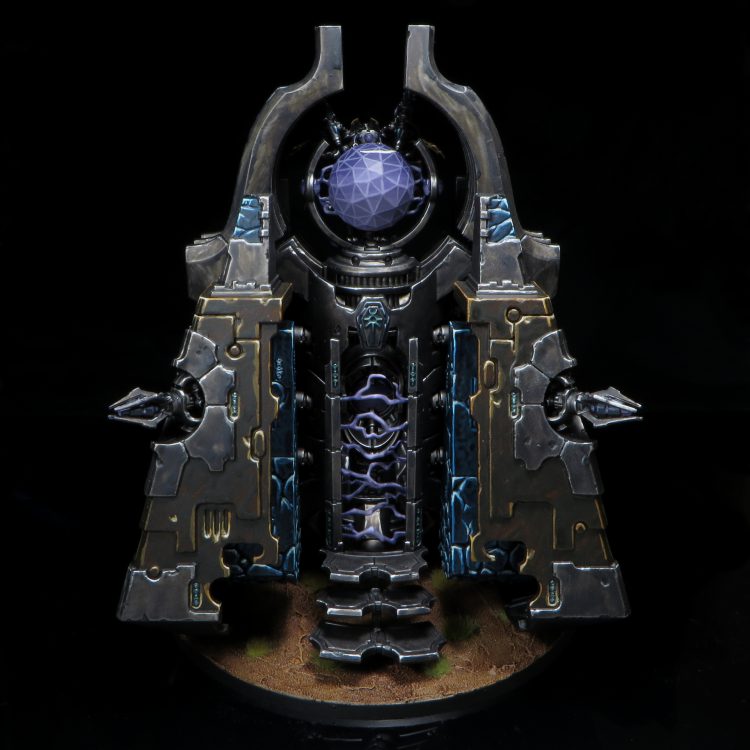
Monoliths as a Transport
The new Eternity Gate has changed a few things in the new Necron Codex and whilst I haven’t been asked yet, I figured we’d go over it now. We all know how much I love transports (ironically I do run a mechanised Tau army, I’m just a glutton for punishment).
Eternity Gate: In your Movement Phase, if this model Remains Stationary, then in the Reinforcement step of that Phase it can summon a unit. If it does, selection one <DYNASTY> CORE INFANTRY unit from your army that is in Strategic Reserves: set up that unit anywhere on the battlefield that is wholly within 3” of this model and not within Engagement Range of any Enemy models. Models in units that are set up using this ability count as having moved a distance equal to their Move Characteristics in the Movement Phase.
So this changes a lot of things about Eternity gate.
- It no longer allows you to set up any number of units in reserve, in fact it allows you to set up none itself. It now requires that you have some units in Strategic Reserves to come in.
- It no longer counts as “disembarking” least not rules as written in the book. So these units are fair game for anti reserve abilities or Stratagems like Auspex scan (arguably some disembarking units are already see the next question).
- The Monolith has to remain stationary to do this, it can’t move after the unit gets out like it used to.
All this adds up to a pretty significant change, and it’s worth noting that if the Monolith uses Death Descending to arrive on the board then it can actually only use Eternity Gate once in a GT2020 game. This is because the Monolith itself can only arrive in Turn 2, and when it doesn’t meet the criteria of having Remained Stationary. On turn 3 it finally can Gate a single unit in, but it can’t gate any more in in turns 4 and 5 because by that point any units that are still in reserves are destroyed. Wings Note: you do have one way round this, which is to use the Prismatic Dimensional Breach stratagem. This lets you set up a unit in the same way as above in your reinforcements step – but crucially it doesn’t have the requirement that the Monolith remained stationary. This means that as it currently stands you can use it to bring a unit in straight after the Monolith itself deep strikes. It wouldn’t shock me to see this errataed so that the Monolith has to have been on the battlefield at the start of the phase, as it essentially lets you deep strike a unit from Strategic Reserves only 6″ away from the enemy, something usually reserved for very specific and telegraphed stratagems, but it works for now.
How do The Silent King’s Obeisance Generators work?
The new Fight Order Commentary now contains a pretty through example of how Obeisance Generators work but here’s the new and improved Fight Phase Order. Where do Obeisance Generators fall though; well they’re a Fight Last effect.
The rare rules then clarify a few things: 1. If a unit has charged it is a ‘fights first’ unit that turn. 2. A unit is a ‘fights first’ unit whether it is under the effect of just one, or multiple, ‘fight first’ rules. 3. A unit is a ‘fights last’ unit whether it is under the effect of just one, or multiple, ‘fight last’ rules. 4. If a unit would be both a ‘fights first’ and a ‘fights last’ unit at the same time, it is instead a ‘fights normally’ unit.
The only other thing the rare rule does is clarify which units are eligible to fight, and so can make use of the Counter-offensive Stratagem (which lets a unit ‘fight next’). In practice, using the above terms, you can select any ‘fights first’ or ‘fights normally’ unit for this Stratagem.
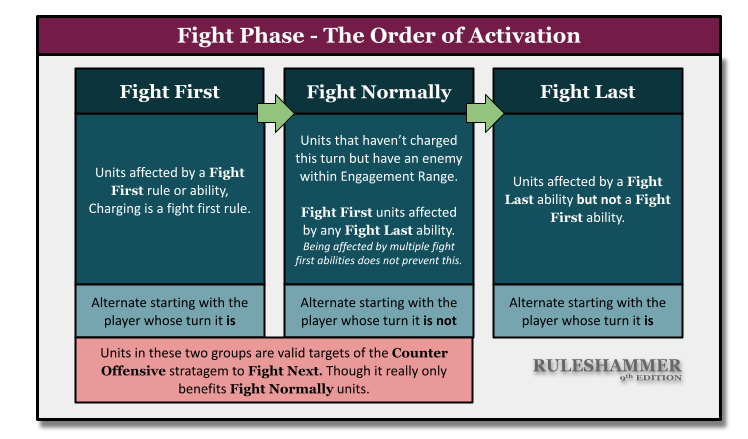 So vs a unit that has charged or has another Fight First rule, Obeisance makes those units fight normally. Against a unit that has no Fight First rules though, they are forced to Fight Last; though more accurately they must fight after all eligible Necron units have fought. They don’t have to fight absolutely at the end. One remaining point of contention here though is how Counter Offensive interacts with Obeisance. Based on how the commentary lays out the rule any unit that has been made to Fight Last is not an eligible target for Counter Offensive, this doesn’t 100% line up with the wording of Obeisance Generators though.
So vs a unit that has charged or has another Fight First rule, Obeisance makes those units fight normally. Against a unit that has no Fight First rules though, they are forced to Fight Last; though more accurately they must fight after all eligible Necron units have fought. They don’t have to fight absolutely at the end. One remaining point of contention here though is how Counter Offensive interacts with Obeisance. Based on how the commentary lays out the rule any unit that has been made to Fight Last is not an eligible target for Counter Offensive, this doesn’t 100% line up with the wording of Obeisance Generators though.
Obeisance Generators: At the start of the Fight phase, if there are any enemy units within Engagement Range of Szarekh, then until the end of the phase, those units cannot fight until after all other eligible units from your army have done so.
however the commentary is pretty clear on the intent here, and so far Silent King and the Whirlwind stratagem are the only abilities that use “cannot fight” rather than “not eligible”. It’s a shame that the FAQs didn’t change their wording but I think the commentary is still enough written intent to play these as described by the rules writers. Maybe send an email to the GW FAQ department though and we can get the wording amended to match!
Number of Attacks for weapons that do “additional” attacks.
Thanks so much for your expertise and awesome explanations! It’s really help me get started in Warhammer (started Oct 2020). Question about how the # of attacks (fight phase) is calculated when there are special weapon abilities. Skorpekh destroyers have 3 attacks. When wielding the Hyperphase Thresher weapon, it says that “Each time the bearer fights, it makes 1 additional attack with this weapon”. Does this mean that the number of Attacks = 6 or 4? As these models have 2 Threshers apiece, I can see the argument for 6 attacks (3 attacks with 2 blades = 6 attacks) as well as 4. Thanks. – Mike Necrons actually have two units like this that I’m aware of, other than just the Skorpekhs, so let’s cover them both.
Skorpekh Destroyers
The first thing to notice is that the models do not have 2 Hyperphase Threshers, they have a single weapon called Hyperphase Threshers plural. That single weapon profile represents all the weapons they are equipped with. With that established it’s the exact wording of the ability for the Hyperphase Threshers is what matters here.
Each time the bearer fights, it makes one additional attack with this weapon.
Fighting in the 9th ruleset is not making an attack with the weapon, it’s being activated to fight in the fight phase. This only happens once per unit, unless the unit is affected by an ability that allows it to fight again. So for the models equipped with Threshers it’s their base 3 attacks + 1 Additional attack, for 4 attacks total for that fight activation. If the models did have multiple Threshers it would be one additional per weapon though, for a total of 5.
Ophyidian Destroyers
These are a little bit more confusing. Again the weapons are plurals so regardless of how many threshers or closes these models have stuck to them the profiles represent all of them. The standard load out with Hyperphase Threshers and Ophydian Claws will have 3 base attacks, you can choose which weapon these are resolved using though between the two and then you get the additional attacks for the two weapons on top of that. So the model could chose for example to allocate them like this;
- 3+1 Hyperhphase Thresher Attacks and 2 Ophydian Claw Attacks OR
- 1 Hyperphase Thresher Attack and 3+2 Ophydian Claw Attacks OR
- X+1 Hyperphase Threshser Attacks and Y+2 Ophydian Claw Attacks where the values used satisfy X+Y=3
The special model in the unit that replaces it’s threshers with a reap blade can also choose how it allocates, so it could decide to put all of it’s attacks into the claws if it really wanted to, not that I can think of a reaon why you would ever want to.
Aetheric Interception in Round 1?
Q: Can AETHERIC INTERCEPTION be used on the 1st turn or does the no first turn deepstrike rule say it cannot be used? Unfortunately you can’t use this Stratagem in Turn 1 if the mission rules preclude it – you need a very specific exception to this rule which it Aetheric Interception does not grant.
In Grand Tournament 2021 missions, Strategic Reserve and Reinforcement units can never arrive on the battlefield in the first battle round. Any Strategic Reserve or Reinforcement unit that has not arrived on the battlefield by the end of the third battle round counts as having been destroyed, as do any units embarked within them (this does not apply to units that are placed into Strategic Reserves after the first battle round has started).
The missions rules are pretty specific that no unit can do it but because 40k is a permissive rule set, a rule that says you can ignore another rule is correct.
Drop Pod Assault: This transport must start the battle set up high in the skies (see Death From Above) but neither it, nor any units embarked within it, are counted towards any limits that the mission you are playing places on the maximum number of Reinforcement units you can have in your army. This transport can be set up in the Reinforcements step of your first, second or third Movement phase, regardless of any mission rules. Any units embarked within this transport must immediately disembark after it has been set up on the battlefield, and they must be set up more than 9″ away from any enemy models. After this transport has been set up on the battlefield, no units can embark within it.
Which is exactly what Drop Pods have, a very specific rule that lets them do this “regardless of any mission rules”.
Use this Stratagem in the Reinforcements step of your opponent’s Movement phase, after an enemy unit has been set up on the battlefield. Select one HYPERSPACE HUNTER unit from your army that is either on the battlefield, in a hyperspace dimension or in Strategic Reserves.
- If that HYPERSPACE HUNTER unit is in a hyperspace dimension or in Strategic Reserves, set it up anywhere on the battlefield that is within 18″ of that enemy unit and more than 9″ away from any enemy models.
And unfortunately Necrons don’t have that clause.
Drop Pod vs Aetheric Interception
Q: Can a Necron unit use Aetheric Interception to restrict the space around a drop pod for disembarking models? The short answer is “no,” and it’s to do with GW’s rather spare timing rules, and not even because of the sequencing rule. Let’s look at Drop Pod Assault:
DROP POD ASSAULT
This transport must start the battle set up high in the skies (see Death From Above) but neither it, nor any units embarked within it, are counted towards any limits that the mission you are playing places on the maximum number of Reinforcement units you can have in your army. This transport can be set up in the Reinforcements step of your first, second or third Movement phase, regardless of any mission rules. Any units embarked within this transport must immediately disembark after it has been set up on the battlefield, and they must be set up more than 9″ away from any enemy models. After this transport has been set up on the battlefield, no units can embark within it.
this ability says they must immediately disembark.
AETHERIC INTERCEPTION
Use this Stratagem in the Reinforcements step of your opponent’s Movement phase, after an enemy unit has been set up on the battlefield. Select one HYPERSPACE HUNTER unit from your army that is either on the battlefield, in a hyperspace dimension or in Strategic Reserves. If that HYPERSPACE HUNTER unit is in a hyperspace dimension or in Strategic Reserves, set it up anywhere on the battlefield that is within 18″ of that enemy unit and more than 9″ away from any enemy models.
This stratagem doesn’t say immediately. Immediately has a glossary definition in GT2020/21, which says “see When” and When’s definition is
When: If a rule states that it takes place when a certain trigger is occurs, unless otherwise specified, that rule takes place before any others.
So the Drop Pod Assault disembark takes place before any other rules in this case. This comes up in a few different places so it’s a key thing to look out for. If both rules said “immediately” or if both of them didn’t however, it would default to the sequencing rule and be up to the current active player what order those abilities would resolve in.
Can a unit move after using Veil of Darkness?
No. There’s a Rare Rule the explains why. First of all Veil of Darkness is a rule that repositions a unit:
VEIL OF DARKNESS Once per battle, in your Movement phase, the bearer can use this Relic. If it does, the bearer’s unit and up to one friendly <DYNASTY> CORE unit within 3″ of the bearer can be removed from the battlefield and set back up anywhere on the battlefield that is more than 9″ away from any enemy models. If two units are set back up on the battlefield using this Relic, both units must be placed wholly within 6″ of each other.
which is covered by a very specific and extensive Rare Rule copied almost straight from the FAQs of 8th edition, which is a bit odd as it one of the Rare Rules we’ve had from day one that probably would be nice to have in the main rules somewhere. Without it there it’s not present in the Core Rules at all.
REPOSITIONED AND REPLACEMENT UNITS Some rules enable units to teleport or else be repositioned and set back up on the battlefield. Other rules enable units to removed from the battlefield and be replaced by a new, full-strength unit, which is then set up on the battlefield. If a rule causes a unit to be removed from the battlefield and subsequently set back up, the following rules apply to it:
-
- Rules that are triggered by or apply to units that are ‘set up on the battlefield as Reinforcements’ are also triggered by and apply to that unit when it is set up on the battlefield.
- Models in units that arrived as Reinforcements count as having moved a distance in inches equal to their Move characteristic this Movement phase. If the unit has a minimum Move characteristic, it counts as having moved its maximum Move characteristic.
- The unit cannot make a Normal Move, Advance, Fall Back or Remain Stationary that turn for any reason.
So Veil of Darkness units are considered to have moved already like Reinforcement units, and can’t move that turn for any reason. This is also the Rare Rule that prevents units from being brought on as Reinforcements and then made able to move again by abilities such as Warp Time or the Swarmlord’s Hive Commander ability. It prevents deepstrike or repositioned units from getting closer than 9″ for trivially easy charges. Have any feedback or questions to submit? Drop a note in the comments below or email us at contact@goonhammer.com. Or head over to the Ruleshammer subreddit to discuss.
